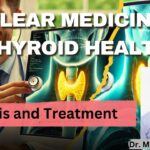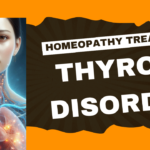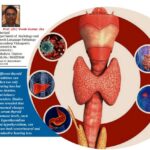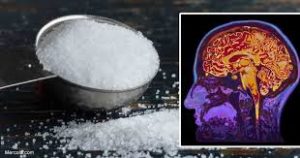

Iodine is a chemical element (like oxygen, hydrogen, and iron). It occurs in a variety of chemical forms, the most important being: iodide (I-), iodate (IO3-), and elemental iodine I2. It is present in fairly constant amounts in seawater but its distribution over land and fresh water is uneven. Thyroid hormones are very important hormones required for the normal growth & function of the body. Humans need iodine for normal thyroid function, and for the production of thyroid hormones.
Sources of iodine
Iodized salt, table salt with iodine added, is the main food source of iodine. Seafood is naturally rich in iodine. Cod, sea bass, haddock, and perch are good sources. Kelp is the most common vegetable seafood, with rich source of iodine. Dairy products also contain iodine. Other good sources are plants grown in iodine-rich soil. Iodine Deficiency is especially associated with high mountains (e.g., Himalayas, Andes, Alps).
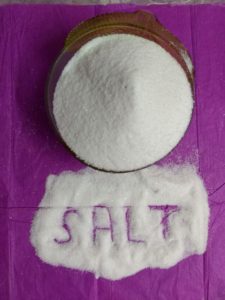

- 150 micrograms for men
- 120 micrograms for women
- 175 micrograms during pregnancy, 200 micrograms during lactation.
- Children 70-150 micrograms
- Infants 50-60 micrograms
In the developing fetus, baby and young child, the effects of iodine deficiency are serious, including stunted growth, diminished intelligence and mental retardation. Deficiency occurs more common in women than in men. Also it is more common in adolescent girls. Iodine deficiency is particularly more severe in pregnancy. It can cause infertility, miscarriage and congenital anomalies in children.
Iodine deficiency disorders
Goiter: Patients with IDD most commonly present with goiter. A typical endemic goiter is present in children with diffuse goiters, while adults present with nodular goiters. If a goiter is large enough, patients may complain of pressure symptoms such as hoarseness, shortness of breath, cough or difficulty for swallowing.
Hypothyroidism: Individuals with severe iodine deficiency may also have hypothyroidism and may complain of fatigue, weight gain, cold intolerance, dry skin, constipation, or depression.
Cretinism: Cretinism is the most extreme manifestation of IDD. Cretinism can be divided into neurologic and myxedematous subtypes. These subtypes have considerable clinical overlap.
Mental retardation: IDD also can lead to mental retardation.
Diagnosis
Iodine deficiency can be diagnosed by
- Measuring Iodine level in the body
- Hormone study such as study of T3, T4, TSH,
- Free T3 and free T4.
- Doppler Scanning of thyroid glands.
Treatment
Iodine deficiency has been treated by several methods, including voluntary use of iodized salt, iodine supplementation in bread, water and oil.
- Thyroxine hormone supplement can be used to decrease the goiter size.
- Radioactive iodine (I131) are used, to decrease thyroid size in patients with euthyroid goiters.
- Partial removal of the thyroid gland may be prescribed for patients with pressure effect of a large goiter on the surrounding structures.
Prevention
IDD can be prevented by the iodination of food products or the water supply. In practice, this is usually achieved by iodination of salt.
- Drinking between half to one liter of milk a day.
- Using iodides salt (though you shouldn’t eat more salt than usual).
- Eating food rich in iodine.
Complications of Iodine treatment
The primary complication of iodine therapy for IDD is the development of hyperthyroidism. This may occur, especially in patients older than 45 years. Hence we should not eat too iodized salt.
IDD is one of the commonest diseases that is easily preventable. Pregnant women and school aged children are common groups that are observed to monitor iodine sufficiency, because they are easily accessible and are particularly vulnerable to the adverse effects caused by iodine deficiency.


Dr. C. Sharath Kumar
Mediwave I.V.F & Fertility Research Hospital
City X-ray Complex,
Sayyaji Rao Road,
Mysuru-570 001
Ph: 0821-2444441



